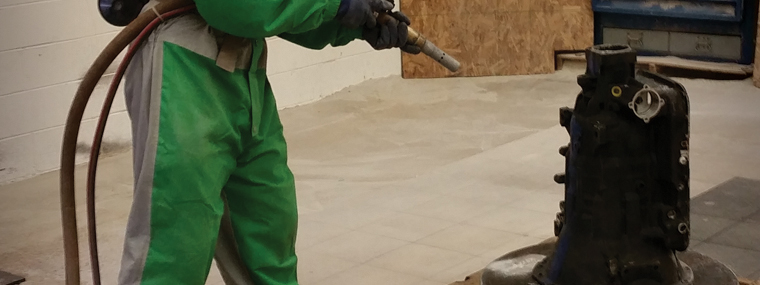
Safety: Safety Series, Part 11: Working Without Water:
Safety Concerns When Pressure Cleaning with Alternate Media
By Terri Perrin

With more than 40 years of construction industry experience, Don Gray of Omaha, NE, knows that a progressive business needs to adapt and change to be successful. That’s what happened about eight years ago, when a manager at Eaton Transmission asked Industrial Coatings, Inc., if they could clean the interior metal ceiling and trusses of a manufacturing facility.
“Power washing or waterjetting was out of the question,” recalls Gray, “so we researched how we could do the work, without damaging the expensive equipment on the floor. That’s how we got started with dry ice blasting, and Industrial Dry Ice Cleaning became a new division of our company.”
As prudent business owners, Gray and his team thoroughly researched various options for blasting media and the measures that they needed to employ to be industry compliant and keep their workers safe.
The Occupational Safety and Health Administration (OSHA) explains that abrasive blasting uses compressed air or water to direct a high-velocity stream of an abrasive material to clean an object or surface, remove burrs, apply a texture, or prepare a surface for the application of paint or another type of coating. Employers must protect workers from the hazardous dust levels and toxic metals that may become airborne from both the blasting material and the underlying substrate and surfaces being cleansed.
Jeff Paduano is the president of ESCA Industries in Hatfield, PA. The company is a supplier of a full line of alternate media blasting equipment and supplies. “When considering alternate cleaning media, it is important to know that there are two categories of products,” explains Paduano. “First we have ‘soft’ media, such as sodium bicarbonate, commonly referred to as baking soda, and dry ice. And then we have ‘hard’ or abrasive media. Two examples include crushed, recycled bottle glass and Jet-Mag, which is an effective silica- and heavy metal-free replacement for silica sand.”
Blasting Beware
When it comes to the use of abrasive media, Paduano warns that you must avoid silica sand because the dust contains tiny silica particulates. When inhaled, silica enters the lungs and causes a deadly disease called silicosis. Surprisingly, the use of silica sand is not outlawed in the USA or Canada, but many industry professionals feel that it should be. New legislation to strengthen the usage guidelines may be pending.
There is an old saying ‘when you know better … you do better.’ This has certainly been the case in the pressure cleaning industry. Once the dangers of some abrasive blasting media were recognized, new and improved alternate media were developed. Recycled bottle glass, for example, is crushed to create a product that is hard, like sand, but free of silica and heavy metals. Several companies also produce abrasive cleaning products made from crushed walnut shells, corn cobs, and other biodegradable materials.
“The new blasting media are not as harmful to human health,” says Paduano, “but the particulates that you are removing in the cleaning process can be harmful. For any soft media blasting, I recommend a battery-Powered Air Purifying Respirator (PAPR) with a full-face shield, and safety glasses under the shield. The PAPR guards against injury to eyes and skin if the product bounces back at the operator, as well as protection from any inhalation of dust and particulates. As with any pressure cleaning, hearing protection is also required.” Industry professionals and OSHA also recommend wearing industrial quality heavy gloves. And you can never go wrong with steel-toed protective footwear on a job site.
Soda Blasting Safety Tips
Joe Alexander, The Soda Works, Walla Walla, WA, clarifies that the sodium bicarbonate used for pressure cleaning is more granulated than baking soda manufactured for home use. It is more similar to the coarseness of table salt. It is an inert substance classed as an ‘A-1 Cleaner’ by the USDA, and it is Kosher certified, which is mandatory for cleaning in most food manufacturing facilities.
“Soda blasting has become very popular because it is highly absorptive and eco-friendly,” explains Paduano. “While it may be gentle on the environment, that doesn’t mean that workers can be complacent about personal safety. The dust created when soda blasting may contain mold; soot; lead paint particulates; or other dangerous contaminants that could cause lung disease, eye irritation, or skin problems.”
Sodium bicarbonate is relatively harmless if it comes in contact with your skin, but you do have to exercise caution and preventative measures when working outdoors with the product. If the soda comes in contact with plant foliage, it will cause leaves to shrivel up. This is not because the product is toxic, but because it absorbs the moisture from the plants.
When soda blasting outdoors, you can minimize the health risks of dust by using a special nozzle, which works with a standard garden hose to water down the blasting media. The operator should still wear earplugs and safety glasses, but full facial respiration protection may not be required.
Advantages and Disadvantages of Dry Ice
Gray says that dry ice is highly advantageous in many indoor situations because it is a non destructive cleaning method. It is gentle enough to clean drywall, yet strong enough to remove rust from steel to make it scale-free and ready for rust compatible primers. The process works by continually propelling dry ice against a contaminated surface at sonic speeds, with the temperature of 109 degrees below zero. The dry ice instantly freezes the first few microns of the contaminant, causing micro-cracking of the product to be removed. Extreme care should be used to avoid projecting the dry ice on any body part, even if covered by personal protective equipment. And always be sure to wear industrial grade insulated gloves.
“I also like the fact that there are no media clean-up or disposal costs,” adds Gray. “And it is safer than many hard blasting mediums because there is no ‘blow back’ of the dry ice because it immediately turns to CO2 gas as it hits the object being cleaned. This rapid conversion from a solid to gas, without the formation of a liquid state, is called ‘sublimation.’
“Operators need to be aware that this sublimation process results in a huge safety concern. When dry ice sublimates into CO2, it is heavier than air. Think of it like invisible water. It will flow into any area or pit, filling it with CO2, displacing the oxygen, and thereby killing any oxygen breathing person or animal. For this reason, it is vital that you wear the appropriate PPE.”
Gray also recommends hanging plastic sheets or canvas screens to section off areas where dry ice blasting is performed, to prevent overspray and safeguard against accidentally spraying the product on people. For added safety, Gray adds that dry ice blasting with a hose more than 25 feet in length requires two technicians. One tech keeps the unit full of dry ice and manages the hose from getting caught while the gun operator moves on his round of cleaning.
Other Cleaning Considerations
“Regardless of the blasting media that you use, one aspect of pressure cleaning that we should also always be aware of is the quality and condition of the pressure equipment itself,” concludes Alexander. “Look for products that have the American Society of Mechanical Engineers (ASME) Boiler and Pressure Vessel Certification.”
Stacey Stone, from Millarville, MD-based Chesapeake Soda Clean Services, started in this industry in 2004, after a career as a firefighter. He is a champion of industrial safety and the proper use of PPE. “Regardless of the blasting media that you use, common sense on the job site should always prevail,” advises Stone. “Know that there is the potential to create airborne particulates. Understand that oxygen deprivation could be a hazard. Analyze the job site in advance. Consider how the work you are doing will affect the environment and your staff. Determine what level of PPE you need, and outfit your crew appropriately.”
To read OSHA’s Fact Sheet on ‘Protecting Workers from the Hazards of Abrasive Materials Blasting’, visit www.osha.gov/Publications/OSHA3697.pdf.





